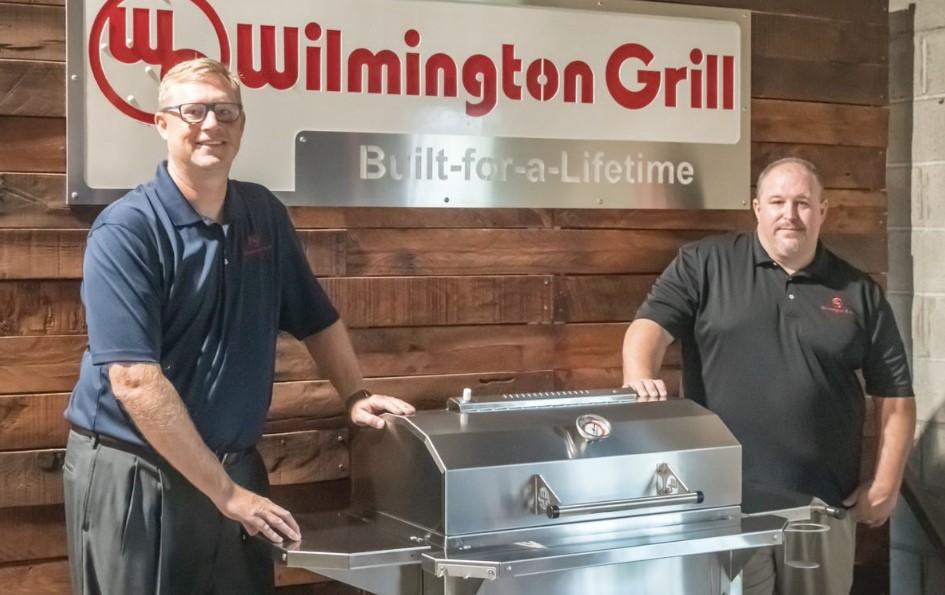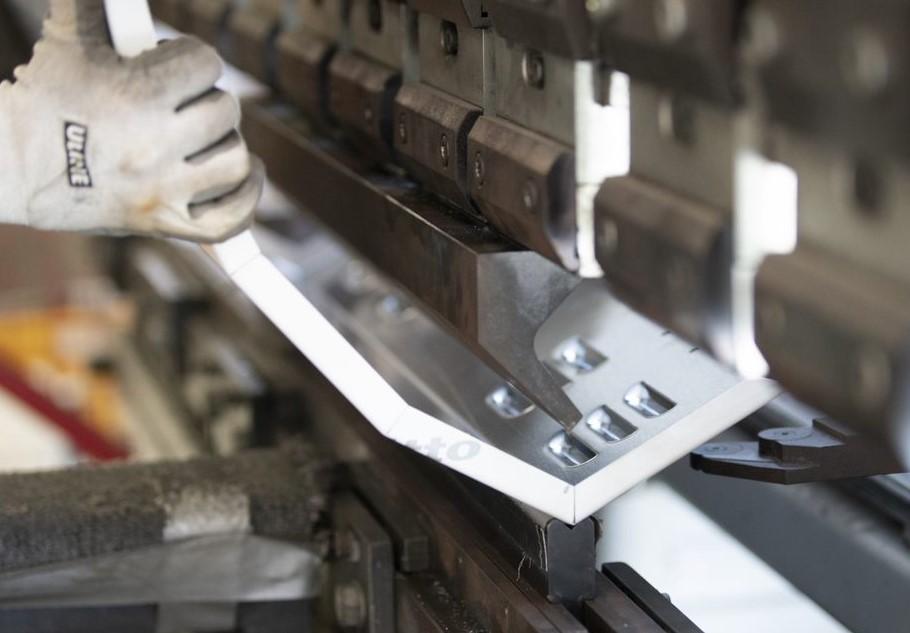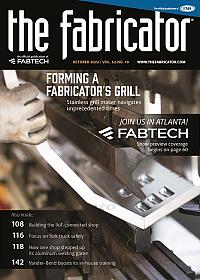Senior Editor
- FMA
- The Fabricator
- FABTECH
- Canadian Metalworking
Categories
- Additive Manufacturing
- Aluminum Welding
- Arc Welding
- Assembly and Joining
- Automation and Robotics
- Bending and Forming
- Consumables
- Cutting and Weld Prep
- Electric Vehicles
- En Español
- Finishing
- Hydroforming
- Laser Cutting
- Laser Welding
- Machining
- Manufacturing Software
- Materials Handling
- Metals/Materials
- Oxyfuel Cutting
- Plasma Cutting
- Power Tools
- Punching and Other Holemaking
- Roll Forming
- Safety
- Sawing
- Shearing
- Shop Management
- Testing and Measuring
- Tube and Pipe Fabrication
- Tube and Pipe Production
- Waterjet Cutting
Industry Directory
Webcasts
Podcasts
FAB 40
Advertise
Subscribe
Account Login
Search
Streamlined metal fabrication of the 'monster' stainless grill
A specialty grill manufacturer based out of North Carolina navigates unprecedented times
- By Tim Heston
- October 15, 2022
- Article
- Shop Management

(From left) Jon Barber, general manager, and Shane Harris, manufacturing manager, stand by JCC Outdoor Products’ signature product, the Wilmington Grill.
Jon Barber pointed to a cart full of 304 stainless steel, cut blanks with louvers and all, propped up and protected on carpeted carts. Even a tiny scratch can spur some expensive rework, and enough of a cosmetic blemish can scrap what is, especially now, a very expensive part.
“Those pieces will be assembled into a grill and shipped in less than 24 hours,” he said. “That’s how quickly things flow around here.”
Barber is general manager of JCC Outdoor Products, manufacturer of a variety of stainless steel creations, including the one it’s best known for, the Wilmington Grill. “It’s a monster of a grill. Everything is 16 ga. or thicker. It’s heavy-duty and it’s all stainless. We still hear from people with grills that are more than 20 years old. They’re still running them and they love them. We don’t have a lot of gimmicky accessories. The main thing is they’re built to last. If someone skilled in the art of metal fabrication made a grill, this is the kind of grill they’d make.”
That monster of a grill is made by a handful of highly cross-trained craftspeople in a small plant in (where else?) Wilmington, N.C. The organization has tripled its throughput over the past decade with the same number of employees. And considering the roller coaster over the past two years—skyrocketing demand with the pandemic, coupled with a constrained supply of stainless 304—JCC wouldn’t be where it is today if its production cycle wasn’t so short.
Cleaning House
Members of the Barber family are no strangers to metal fabrication. Jon’s father Dave was president of Megafab and served as president and chairman of the board at the Fabricators & Manufacturers Association (FMA) in the early 2010s. “My dad had worked in the fabrication industry for a long time, and it was always his dream to own a company. He was living in South Carolina, he was looking, this opportunity came about, and he jumped on it.”
The Wilmington Grill brand has been around for more than 20 years. The inventor founded the company and sold it a few years later to another firm, which ran the organization for several more years before the Barbers purchased it in 2011. “I moved down a couple years after my parents purchased it,” Barber said. “I’ve been with the company about nine years now and became general manager once my father passed five years ago.”
When the Barbers purchased the company, they knew the organization produced a quality product that appealed to those passionate about grilling. Focusing on that niche made the business less susceptible to swings in the broader economy. Sure, a stainless steel grill is a luxury item, but for serious grill masters, it’s an important luxury item.
They also saw opportunity for improvement. In the early 2010s, Wilmington Grill operated in a traditional way, maximizing machine uptime with large batches. The idea was for the punch, laser, and press brakes to form everything for a certain number of grills in a week, after which the job moved on to assembly.
The method seemed logical. After all, it gave people the ability to maximize uptime at their machines. But the method also piled up work-in-process (WIP) between workstations and before assembly. Part flow also backtracked through the plant, and those handling the jobs had to navigate around racks of material and tools, some of which hadn’t been used for years.
“I’m not a big fan of hoarding,” Barber said. “We had shelves here that sat in the middle of the shop, and they were filled with—I’m going to be nice here—junk. And we don’t have a lot of space to begin with.”
The cleanup commenced about eight years ago. They threw away old parts, machines, and tools that hadn’t been used since soon after the company’s founding. Everyone also began scrutinizing the way they scheduled orders and the way those orders flowed.
With so much WIP staged before it, the assembly department was the most obvious bottleneck, and much of it was caused by the way work flowed. Like everyone else, brake operators focused on local, not global (operation-wide) efficiency. And who could blame them? They were given a week’s worth of jobs, and they processed those jobs to ensure they produced the maximum amount of work in the least amount of time. This often meant forming the grill bottom—that is, the bottom shell where the flame ignites—at the end of the week. Thing was, assemblers couldn’t even start assembling until they received that bottom piece. “That’s why we started prioritizing parts based on where they’re required in assembly,” Barber said, adding that such prioritization led to a new way of scheduling. Weekly schedules turned into daily schedules.
Today, parts are cut on the company’s TRUMPF punch press (critical for forming the necessary louvers) and AMADA fiber laser. Programmers nest parts both for orders immediately due and filler parts, to maintain maximum material yield. Parts emerge from laser cutting and head to deburring. (JCC produces consumer, food-grade products; every blank must be deburred to ensure safe edges.)
JCC uses custom, carpeted carts to transport the needed blanks to forming, where operators form the work based on what those in assembly need. To make this kind of flow possible, the company streamlines its setup procedures to ensure operators have everything they need for a quick changeover. They also optimize certain setups so the same segmented toolsets can process a range of different products. This prevents operators from constantly tearing down and setting up between jobs.
Certain parts head downstream, where most are gas tungsten arc welded, then on to grinding and polishing and final assembly. The team even scrutinizes the carpeted assembly tables to ensure assembly occurs ergonomically, with minimal movement and easy part manipulation. Deep scratches or dings can scrap a part or even an entire assembly—and considering all the value that has been added to the work upstream, assembly is an expensive place to scrap a job.
“If assembly isn’t doing what they need to do, and if nothing is getting in boxes, we’re not shipping,” Barber said. “We need grills in boxes, and we need to make sure we’re constantly feeding our assembly area with parts, so they can get work out the door.”
Eventually, the team reorganized flow so that work moved smoothly in a circle, with raw stock coming in and finished parts flowing out of the shipping dock. Today, with a quick glance, every shop employee can see what work is on the floor, where it’s headed, and where it has to go.
Simplification
The Barbers know how challenging high-product-mix fabrication can be. Jon’s father David spent his career in countless custom metal fabrication job shops, many of which processed thousands of part numbers, all of different material grades, thicknesses, and destined for different customers, each with different quality and delivery requirements.
JCC lives in a different world. Yes, the sheet metal cutting and bending machines process a wide variety of parts, but the company controls the range of work it produces. In fact, several years ago JCC pruned its product line further, eliminating some custom, make-to-order elements of its catalog. As Barber explained, the company still maintains ancillary products like stainless steel fire pits, tables, even oyster shucking stations (a recent addition). But the vast majority of revenue comes from the Wilmington Grill line.
“We’ve consolidated our product line to standard grills,” Barber said. “That’s what we’re great at and where we do best.”

A grill sits on a carpeted assembly table. The protective film stays on the product as it ships to dealers.
Such standardization helps simplify the operation and boost part flow velocity. Even better, JCC fabricates only stainless steel. “We know what cross-contamination can do,” Barber said, adding that processing just a single material type “helps ensure our parts our protected throughout the process.”
Processing just one material type helps streamline the entire operation. Settings for laser cutting are dialed in to produce a clean edge; setups in forming allow for the increased springback of stainless steel; and welders wielding a GTAW torch know how to lay down a good-looking bead that emerges from the electropolishing station with that clean, stack-of-dimes look.
“Processing only stainless has allowed us to focus on what we do best. It’s been so great for us.” Barber paused, then sighed quietly. “Until, of course, the supply chain problems hit us.”
Supply Chain Complications
Demand at JCC is usually seasonal. Orders slow in January, then build in February through June and July. That’s followed by a slower August as demand heads down to a winter trough, before heading back up to the next peak during the spring and summer buying season.
2020 was different. Early in the year, the company was off to a great start, with sales higher than normal. But as the pandemic hit in March, everything slowed dramatically—before skyrocketing back up just a few weeks later. “People are staying home,” Barber recalled, “and all of a sudden, the next thing we know, the outdoor products world goes completely gangbusters.”
Now, all that work to streamline workflow was paying off big time. High part-flow velocity meant that material didn’t stay on the shop floor for long, which was a very good thing considering the rising price of stainless. The shop ramped up and was able to meet unprecedent demand. The company installed its new fiber laser in early 2021—but soon after the supply chain issues began.
Supply constraints presented JCC with unprecedented challenges. Its entire business model is built off of fabricating grills out of a single material grade—304 stainless steel. The grade provided the corrosion resistance that allowed the grills to last forever. It was also less expensive than other stainless grades, like 316.
Barber pointed to the raw stock area. In years’ past, the company kept several weeks’ worth of inventory, just to ensure the operation could respond to demand spikes. Now, much of the stock area sits empty. Demand is still high, but now more than ever, available supply dictates what JCC produces.
The situation has forced everyone to become more agile. Suppliers might report that they have a batch of 304, 5- by 10-ft. sheets coming, and so programmers prepare nests for those standard sheet sizes—only to find that the sheets are really 4 by 8 ft. They change the nests, alter the filler parts they use to maximize yield, and send the job to the laser.
Flexibility in nesting has been key. For instance, its new fiber laser has an on-the-control drag-and-drop nesting feature. The operator can load a sheet, then use the control’s touch interface to drag and drop a part geometry into an open space—a useful feature for nesting remnants. This year, it has also helped operators slip pieces in where needed, reacting to changes in supply.

The JCC team poses by the Wilmington Grill. The shop employs about 10 people, and even though throughput has tripled over the past decade, the company headcount hasn’t.
“We’ve been scheduling differently this year,” Baber said. “We look at what material we have and we then determine how many grills we can make, and what type. If we can’t get enough material, we might make little traveler grills, which don’t use as much material. Or we might fabricate fully assembled grills for local dealers. Those take longer to make and, hence, don’t consume as much material.”
As of this writing, the supply constraint has started to loosen, and JCC has been able to produce according to customer demand. Regardless, the supply chain crunch has been a kind of stress test for JCC’s new approach to material flow.
Over the past decade it has allowed the company to triple output without adding dozens of people or multiple layers of management. Moreover, every JCC employee is cross trained, and everyone moves where needed to open a constraint and get a product out the door.
“One of the great things about being small, we don’t have all these levels to the organization,” Barber said. “If we see something that’s not working correctly, we can make a change within minutes.”
A decade ago, it took well over a week for cut blanks to turn into finished products. As the pandemic hit in 2020, it took less than a day—a metric that hasn’t changed for the past two years. That quick response, Barber said, has fueled growth and helped navigate through uncertainty. And he doesn’t see that changing any time soon.
“We’re a nice family business that makes a great product in a great market niche,” Barber said. “We plan to keep it that way.”
About the Author

Tim Heston
2135 Point Blvd
Elgin, IL 60123
815-381-1314
Tim Heston, The Fabricator's senior editor, has covered the metal fabrication industry since 1998, starting his career at the American Welding Society's Welding Journal. Since then he has covered the full range of metal fabrication processes, from stamping, bending, and cutting to grinding and polishing. He joined The Fabricator's staff in October 2007.
Related Companies
subscribe now

The Fabricator is North America's leading magazine for the metal forming and fabricating industry. The magazine delivers the news, technical articles, and case histories that enable fabricators to do their jobs more efficiently. The Fabricator has served the industry since 1970.
start your free subscription- Stay connected from anywhere

Easily access valuable industry resources now with full access to the digital edition of The Fabricator.

Easily access valuable industry resources now with full access to the digital edition of The Welder.

Easily access valuable industry resources now with full access to the digital edition of The Tube and Pipe Journal.
- Podcasting
- Podcast:
- The Fabricator Podcast
- Published:
- 04/16/2024
- Running Time:
- 63:29
In this episode of The Fabricator Podcast, Caleb Chamberlain, co-founder and CEO of OSH Cut, discusses his company’s...
- Trending Articles
AI, machine learning, and the future of metal fabrication

Employee ownership: The best way to ensure engagement

Steel industry reacts to Nucor’s new weekly published HRC price

Dynamic Metal blossoms with each passing year

Metal fabrication management: A guide for new supervisors

- Industry Events
16th Annual Safety Conference
- April 30 - May 1, 2024
- Elgin,
Pipe and Tube Conference
- May 21 - 22, 2024
- Omaha, NE
World-Class Roll Forming Workshop
- June 5 - 6, 2024
- Louisville, KY
Advanced Laser Application Workshop
- June 25 - 27, 2024
- Novi, MI




























